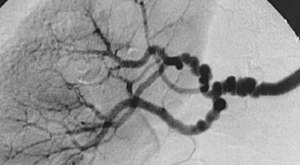Fibromuscular dysplasia
| Fibromuscular dysplasia | |
|---|---|
 |
|
| The "string beans" feature in multi-focal fibromuscular dysplasia. The sign is caused by areas of relative stenoses alternating with small aneurysms. | |
| Classification and external resources | |
| OMIM | 135580 |
Fibromuscular dysplasia (FMD) is a non-atherosclerotic, non-inflammatory disease of the blood vessels that causes abnormal growth within the wall of an artery. FMD has been found in nearly every arterial bed in the body. However, the most common arteries affected are the renal and carotid arteries.
There are various types of FMD, with multi-focal fibroplasia being the most common. Focal (previously known as intimal) and adventitial are less common forms of the disease. FMD predominantly affects middle-aged women, but has been found in men and people of all ages. Pediatric cases of FMD are vastly different from that of the adult population. The prevalence of FMD is not known. Although the disease was initially thought to be rare, recent studies have suggested that FMD may be underdiagnosed.
Signs and symptoms that FMD patients present with is largely dependent on the vascular bed(s) affected. Patients may also be entirely asymptomatic and have FMD discovered incidentally, i.e. when imaging studies are performed for other reasons. In a study from the US Fibromuscular Dysplasia registry, the mean age at first symptom or sign was roughly 47 years of age.
The main symptoms associated with renal FMD are hypertension and bruits that can be heard with a stethoscope over the abdomen or flanks. Complications such as aneurysms, dissections, or occlusion of the renal artery have been associated with renal artery FMD.
The carotid and vertebral arteries are most commonly affected. Middle and distal regions of the internal carotid arteries are frequently involved. Patients with FMD in the carotid arteries typically present around 50 years of age. Symptoms of craniocervical involvement include headaches (mostly migraine), pulsatile tinnitus, dizziness, and neck pain, although patients are often asymptomatic. On physical examination, one may detect neurological symptoms secondary to a stroke or transient ischemic attack (TIA), a bruit over an affected artery, and diminished distal pulses. Complications of cerebrovascular FMD include TIA, ischemic stroke, Horner syndrome, or subarachnoid hemorrhage.
...
Wikipedia
